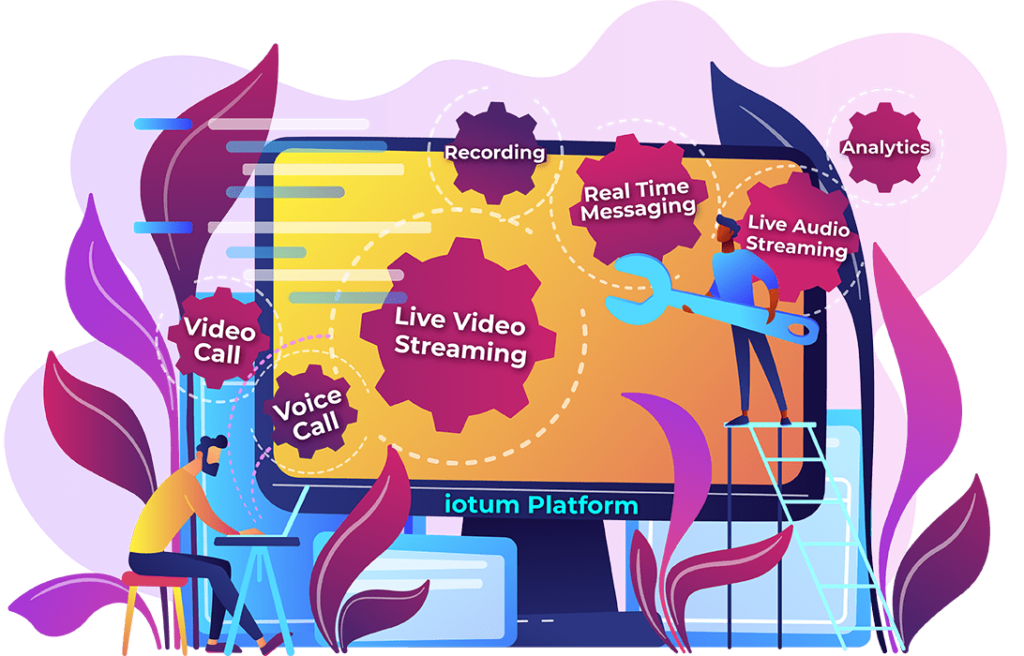 The move to remote work hardly came as a surprise at the beginning of 2020. Any industry that could make the shift to bring work online did so, and it seemingly happened overnight – companies had to rally to figure out the technology that would save their companies. Solving logistics, and uniting teams around the world took place over video conferencing which became the bridge and connection point for many businesses.
The move to remote work hardly came as a surprise at the beginning of 2020. Any industry that could make the shift to bring work online did so, and it seemingly happened overnight – companies had to rally to figure out the technology that would save their companies. Solving logistics, and uniting teams around the world took place over video conferencing which became the bridge and connection point for many businesses.
Now, fast forward a year later, and working from home seems to be the norm. In fact, it’s estimated that by 2025, 22% of the American workforce will be working remotely. To put that in context, that’s an 87% spike from the number of remote workers before the “new normal” became normal!
While the organizational alignment might look and feel better, there seems to be a lag, or fatigue from having to do everything on screen. There are many advantages to working remotely, but ensuring your team stays motivated and on top of things can take extra effort.
Whether you always managed a team of remote employees or suddenly find yourself as part of the cohort that transitioned from office to online, here’s how to manage a remote team in a way that morale, efficiency, innovation, and motivation run high, even amidst uncertainty and unanswered question about the future:
1. Relay Expectations, Define Responsibilities, Update Accordingly
It takes a bit of time to form a new habit. Adapting to a remote workforce draws upon a new managerial skill set that involves transparency with expectations and responsibility. It’s important for the health of the business and the sanity of its esteemed employees and management to foster a sense of trust and authenticity. How does that happen and how will that motivate your remote team?
Setting out expectations involves an agreement – a clear and concise agreement that answers who does what and by when. When these elements are clearly stated in a meeting or in a contract, and everyone understands these expectations, there’s no confusing the defined roles, responsibilities, and delegations.
 Teams become aligned when responsibilities are clearly outlined. This means each employee knows their duty. Due diligence will naturally follow suit when you give individuals trust and accountability for their actions. With ownership comes pride and productivity which leads to a motivated employee and a motivated team!
Teams become aligned when responsibilities are clearly outlined. This means each employee knows their duty. Due diligence will naturally follow suit when you give individuals trust and accountability for their actions. With ownership comes pride and productivity which leads to a motivated employee and a motivated team!
Think about creating and publishing comprehensive work-from-home guides or holding a regular online “office hours” meeting for questions, concerns, and announcements.
2. Create Parameters To Work Within
Now that many employees find themselves working from home, the home-office barriers have become obsolete. Work and play take place in the same space and can overlap now more than ever. People might feel inclined to work around the clock or take fewer breaks and not leave the house for days! When you don’t have to wear nice business attire, it’s easy for the line between work and life to blur. Don’t let team productivity suffer because employees are feeling cooped up.
Knowing that everyone is available and at home might make it convenient to access employees off hours, but it’s essential to not push past the limits of work. Work-life balance is critical to the welfare of employees and management, and the idea of “high performance” needs to reflect that.
Screen fatigue, restless leg syndrome, and aches from sitting too long can all lead to mental exhaustion. Creating boundaries and staying within the parameters of work will help instill a sense of motivation.
3. Unsure About Morale? Conduct Surveys
If things are feeling a little bleak, there’s no sense in guessing your way around it. Gauging employees’ or management’s emotional temperature online isn’t the most accurate way of assessing the cause or solution. Especially if productivity or the general outlook has gone down, consider creating a survey to assess how people are holding up.
It can be as simple as a recurring 10-minute check-in asking if employees need any additional office supplies or just following up about their week. Try creating a “stoplight” poll that asks employees to tick the green light (everything is good), yellow light (feeling some resistance) or red light (need assistance).
Or it can be more complex. Design a questionnaire that asks employees to share any obstacles that they feel are impeding their ability to produce good work. Ask what makes them feel empowered; Do they feel safe, loyal, valued and taken care of, or unseen, unheard and unsupported? Do they want additional training? More one-on-one time? Try combining specific questions with “true or false” questions and multiple choice for more complete and honest feedback.
4. Check-In On Everyone’s Dedicated Workspace
Since the move from office to online, people have had to make space at home to accommodate the change. In the beginning, things may have been a little more makeshift and complicated. Now, hopefully, employees are feeling more sorted and comfortable. Either way, you’ll never know unless you ask.
For employees to stay motivated, having a dedicated space that allows them to work uninterrupted will provide the best results. Bouncing back and forth between the patio, dining room table, and couch can break up focus or cause disruption.
Living with multiple family members in a small space might prove difficult for those needing a quiet area to get work done. Keep that in mind if an employee’s performance seems low or they aren’t as motivated as they normally are. In this case, ask! See if there’s anything that can be provided for and also suggest that people get creative. It’s amazing how different spaces can take on a whole new feeling when you move furniture or add a light fixture.
5. See How New Technologies Can Create Cohesion
Working in an office meant you could just get up and walk to your colleague’s workspace or hold an impromptu stand-up meeting in the hallway. Relying on technology to stay motivated and connected wasn’t required as much when in-person interactions were frequent, nor were they used to their full potential in an office setting. Realistically, how much technology did you actually use? Probably mostly word processing software and email.
Now that the workforce is spread across town and country, innovation is what helps keep it all together. This is the opportune time to explore which technologies will keep your team on the ball. Project management tools, business communication platforms, and video conferencing software all take the cake when it comes to staying connected in real-time. See how each tool works together through integration with existing technology by taking advantage of trial periods. Some are free while others are low investment. Either way, try a new system to see if it works for you.
 Since in-person interactions aren’t as feasible as they once were, see how video conferencing software can bridge the work management gap for online meetings. With a little forethought and planning, virtual meetings can be just as motivating as being face-to-face, and they can produce great results with adjacent features like screen sharing and an online whiteboard.
Since in-person interactions aren’t as feasible as they once were, see how video conferencing software can bridge the work management gap for online meetings. With a little forethought and planning, virtual meetings can be just as motivating as being face-to-face, and they can produce great results with adjacent features like screen sharing and an online whiteboard.
6. Make Time To Chat
Building team rapport – even in an online setting – is crucial for the health of the team and its individual members.
As management, knowing who you’re working with professionally, alongside knowing a few personal details, creates an online workplace relationship that grows. This could be as simple as having a chat to ask about an employee’s weekend or ask what they’re watching on Netflix. Perhaps it’s breaking the ice in a video conference to ask about someone’s piece of art hanging on the wall. These small gestures create a sense of “relatedness.” They aren’t critically necessary to get work done, but they do make a difference in a person’s sense of worth.
Interpersonal relations are hard to quantify and you don’t want to go overboard with the niceties, but showing that you care about the people you work with over a virtual coffee or a quick catch-up before an online status meeting goes a long way.
7. Fuel Intrinsic Motivation
Rewards and recognition are two age-old methods of keeping employees working at their peak performance. The two motivating factors not only unearth an employee’s full potential, they also help managers to feel that their team is committed.
What it comes down to is an employee’s needs. Rewards and recognition are motivating but only if it aligns with what gets an employee moving:
Rewards
Also referred to as extrinsic rewards, this motivating factor is incentive-based like pay raises, gift cards, and bonuses. Anything that is tangible and reflects an employee’s top-notch performance can be seen as a reward. While these incentives are appealing, rewards are only motivating if people want them. Great perks drive employees to perform better while also increasing an employer’s appeal to potential candidates. Another benefit; Offering rewards like more vacation time, or a company car could compensate for jobs that don’t pay as much.
Alternatively, rewards could lead to short term motivation, cater to a heightened sense of competition over collaboration and teamwork, and could take away from people actually spending time on achieving work results. This could create disharmony as employees would have their “eyes on the prize” and lose focus on the task in front of them.
Recognition
Also understood as psychic rewards, recognition refers to being “applauded” for a job well done. Perhaps it’s an email or written letter detailing someone’s positive and acknowledged efforts, achievements or performance. Recognition, even if just verbal like a shout out in an online meeting or a comment passed down from a superior to a line manager, can have a positive effect in performance.
Furthermore, recognition tends to drive employee motivation more on a day-to-day level. There is no financial investment. An employee’s sense of worth and contribution increases when they receive positive feedback. Teamwork is reinvigorated, organizational values and company culture are reinforced, and most importantly, an employee’s purpose and meaningful presence is highlighted and tended to.
On the other hand, it can be easier to slack off once an employee has been told they’re doing excellent work. It’s easy to “press pause” on their work output or slow down their productivity once they’ve received the acknowledgement that they’ve been able to prove themselves.
In a TED talk from Ted Pink, he mentions 3 key points about keeping motivation high: Autonomy, mastery, and purpose.
According to Pink, “autonomy” is the internal urge to want to be the director and facilitator of our own lives, a concept that aligns with “mastery” which is the desire to get better at something that matters by placing our focus on it.
Essentially, if you want a highly motivated working environment where employees flourish, rewards and recognition help, but it’s a person’s natural drive to do things for their own sake. It’s about finding a “why” for their own personal gain within the ecosystem of how their role plays out in the business. This is called “intrinsic motivation” and when paired with both rewards and recognition, these three elements can be a recipe for a highly motivated, top-performing employee with “purpose.”
With Callbridge, you can rely on state-of-the-art video conferencing to keep teams connected, near or far. Online meeting management isn’t as daunting when you have smooth-running technology that provides the digital tools to keep everyone on track and motivated. Host one-on-ones, group celebrations, award ceremonies, or every day brainstorming and tissue sessions where you can actually see the faces of clients and colleagues with high definition audio and video software.
Callbridge is browser-based and easy-to-use. Enjoy additional digital tools like screen sharing, file sharing, and online meeting recording capabilities for syncs that are engaging and collaborative.


